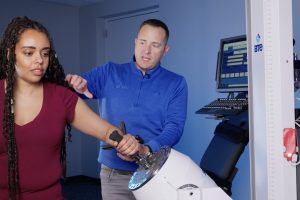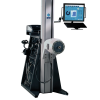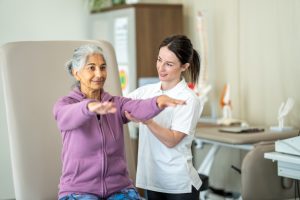
Shoulder Dislocation Rehab Protocol: An Expert Guide to Safe Recovery
Treatment GuidelinesDiscover a step-by-step shoulder dislocation rehab protocol designed to restore function, prevent re-injury, and guide your patients safely from initial evaluation to full return to activity.
Shoulder dislocations are common injuries, particularly in athletes and active individuals. As clinicians, we understand the importance of a structured rehab protocol to ensure safe healing and restore optimal function. A thoughtful and gradual approach not only accelerates recovery but also helps prevent recurrent dislocations and future instability.
This guide provides a clear rehab pathway for patient management, from the initial evaluation to full activity return. It emphasizes evidence-based approaches and offers practical insights into how to treat these injuries effectively at every stage of recovery.
Understanding Shoulder Dislocation
The shoulder is the most mobile joint in the body, but this mobility also makes it prone to dislocations. The shoulder joint is a ball-and-socket joint where the humerus (upper arm bone) fits into the shallow glenoid (part of the shoulder blade). A dislocation occurs when the humeral head moves out of its socket, most often as a result of a traumatic event like a fall or collision.¹
Anterior dislocations are the most common type, where the humeral head moves forward and out of the socket.2 These injuries result in pain, muscle spasms, and potential soft tissue damage, such as injury to the rotator cuff or labrum. Understanding the mechanisms of injury and common complications is critical for designing an appropriate treatment protocol.
Why a Rehab Protocol is Crucial
As rehab professionals, we know that proper rehabilitation is key to reducing the risk of re-injury and ensuring long-term shoulder stability. Skipping phases or rushing recovery can lead to chronic instability, which may require surgical intervention down the line.
An effective rehab protocol for a shoulder dislocation must take into account the patient’s specific injury characteristics, comorbidities, and functional goals. By following a progressive rehabilitation plan, we ensure the safest and most efficient recovery possible.
Phases of Shoulder Dislocation Rehab Protocol
Phase 1: Evaluation
The evaluation phase is critical for establishing a clear understanding of the injury’s nature, measuring the patient’s objective baselines, and determining the best course of treatment. This process involves assessing shoulder stability, range of motion (ROM), and muscle strength, as well as identifying any possible soft tissue damage or neurovascular involvement.
A thorough shoulder evaluation includes tests like the Apprehension Test and Sulcus Sign to assess the severity of laxity and likelihood of recurrent dislocations. An accurate diagnosis in this phase allows for a more tailored shoulder rehab exercises, maximizing recovery and minimizing the risk of complications.
For a detailed overview on how to perform a shoulder evaluation, visit our Mastering Shoulder Evaluations page.
Phase 2: Immobilization and Pain Management
The immobilization phase focuses on protecting the shoulder after a dislocation, allowing the ligaments and surrounding tissues to heal. Sling use is typically recommended for 1–6 weeks, depending on the severity of the dislocation and any prior history of injury.3
This phase aims to reduce pain and prevent further damage. Ice therapy, NSAIDs, and activity modification are key components in controlling inflammation and pain. It’s important to monitor for any complications such as neurovascular issues or persistent instability, which may require further medical intervention.
- Duration: Varies from 1–6 weeks, depending on the severity.
- Precautions: Avoid excessive movement of the shoulder joint and weight-bearing activities.
Phase 3: Restoring Range of Motion
Once the acute pain and inflammation have subsided, the focus shifts to restoring range of motion (ROM). Begin with gentle stretching exercises to improve flexibility and encourage joint mobility without overstressing the healing tissues.
Pendulum swings, passive external rotations, and active-assisted ROM are effective early exercises that help the patient regain motion. The goal is to gradually increase joint mobility without compromising stability. Key benchmarks for progression include the restoration of full passive ROM without pain or discomfort.
- Warning signs: Pain beyond mild discomfort, increased swelling, or instability in the shoulder.
- Progression: Gradually increase the intensity of rehab shoulder exercises while monitoring the patient’s comfort levels.
Phase 4: Strengthening and Stabilization
As the shoulder regains its range of motion, strengthening exercises become the cornerstone of rehabilitation. The goal in this phase is to restore muscle strength and joint stability to prevent recurrent dislocations.
Focus on isometric exercises initially, followed by isotonic strengthening, then functional movement. Movement quality needs to be prioritized before strengthening, and care must be taken to progress gradually without overloading the tissues.
Use the video below to demonstrate key shoulder strengthening exercises:
- Important considerations: The shoulder is only part of the puzzle. Scapular stabilization, core support, and breath control are all essential for supporting the shoulder complex and preventing re-injury.
Phase 5: Return to Activity
The final phase of shoulder dislocation rehab focuses on returning to functional activity, whether that be daily tasks, sports, or work-related functions. The decision to return should be based on the patient meeting criteria for safe return, including full range of motion, minimal pain, and strength restoration.4
Functional exercises should simulate real-life or sport-specific movements. Incorporate sport-specific drills for athletes and job task simulations for workers to ensure the shoulder is prepared for the demands of their activities.
To help your patients return to sport or job tasks more effectively, consider using PrimusRS for task-based functional rehab that mimics real-world movements and progressively challenges the shoulder’s functional capacity.
Recommended Exercises for Shoulder Dislocation Rehab
Below are key shoulder rehab exercises that should be integrated into the rehab program for shoulder dislocation:
Pendulum Exercise (Codman’s Exercise)
This exercise promotes passive shoulder mobility and helps reduce stiffness in the initial stages.
- Reps: 3 sets of 20 seconds each direction (clockwise and counterclockwise).
External Rotation with Resistance Band
Effective for strengthening the rotator cuff and improving stability in the shoulder.
- Reps: 3 sets of 10 reps.
Shoulder Blade Squeeze
Strengthening the scapular stabilizers is essential for shoulder function and injury prevention.
- Reps: 3 sets of 15 repetitions.
Internal Rotation with Resistance Band
Targets the subscapularis and assists in improving shoulder internal rotation strength.
Reps: 3 sets of 10 reps.
Wall Crawl Exercise
This exercise gradually increases shoulder elevation and mobility by using the wall for support.
Reps: 3 sets of 10 reps, gradually increasing height as tolerated.
Isometric Shoulder Abduction
An early-stage strengthening exercise to build muscular endurance around the shoulder joint without strain.
- Hold: 5 seconds per rep | Reps: 10-30
Common Mistakes to Avoid During Rehab
As a rehab professional, avoid the following mistakes during the rehabilitation process:
- Rushing rehabilitation phases: Moving too quickly can jeopardize the healing process and lead to setbacks.
- Ignoring pain and swelling: Pain and swelling should be actively managed to avoid excessive tissue stress.
- Overloading early: Progressing exercises too quickly or too aggressively can hinder healing and lead to re-injury.
- Skipping rest days: Proper rest and recovery are crucial for tissue repair and to avoid overuse injuries.
- Inconsistent evaluation: Regular reassessment ensures that the rehab process is on track and that no complications arise.
When to Seek Professional Help
If you are not a provider and notice that your shoulder pain worsens, your mobility decreases, or instability persists, it’s important to seek professional help. A comprehensive shoulder evaluation can reveal underlying issues that might not be immediately obvious. Don’t wait—early intervention can prevent further damage and speed up your recovery.
Tools to Enhance Shoulder Dislocation Rehab
PrimusRS is for more than just resistance training. Its ability to simulate real-world, task-specific movements—whether sport- or job-related—makes it an invaluable tool throughout the rehab process. From objective strength testing to functional return-to-activity training, PrimusRS supports evidence-based progression that’s both measurable and meaningful.
Explore how Physical therapy equipment for shoulder rehab, like PrimusRS supports smarter, goal-driven recovery.
Building Lasting Shoulder Strength and Stability
Treating shoulder dislocations effectively requires a structured, patient-centered rehab protocol that takes into account the patient’s injury, healing process, and functional goals. By carefully progressing through each phase, you can help your patients recover safely, regain full shoulder function, and return to the activities they love.
Morgan Hopkins, DPT, CMTPT is a Physical Therapist and freelance healthcare writer. She spent over eight years treating patients in outpatient orthopedics before transitioning to medical writing. Her clinical specialties include intramuscular dry needling, dance medicine, and sports medicine. Morgan is extremely passionate about holistic wellness, preventative care and functional fitness and uses writing to educate and inspire others.





